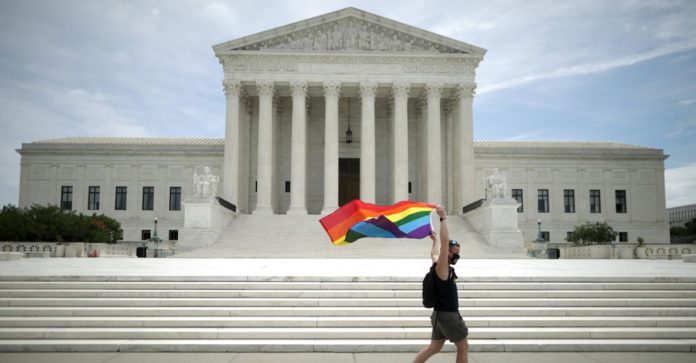
In the legal battle between religious rights and gay rights, religious freedom gained a victory today. The U.S. Supreme Court ruled unanimously that the First Amendment’s religious-freedom protections prevent the city of Philadelphia from refusing to contract with a Catholic foster-care agency that, based on its religious beliefs, does not place foster children with same-sex couples. The decision, Fulton v. City of Philadelphia, is a victory for conservative Christians who have been arguing that the Constitution’s guarantees of religious freedom protect religious organizations and individuals who wish to deny certain services to LGBTQ people.
The Fulton decision is substantial, but it is not the blockbuster outcome that some had expected. In a narrow ruling, the Court determined that Philadelphia’s policies were not neutral toward religion and thus violated the First Amendment’s free-exercise clause. Fulton is in line with the Court’s shift toward a broader interpretation of First Amendment protections, but the Court was divided about the bigger question, specifically whether to expand religious-liberty rights by replacing a 1990 legal precedent, Employment Division v. Smith.
The Smith decision was written by Antonin Scalia, the late conservative justice, and it limited the rights of a religious minority—Native Americans—stating that free-exercise rights could not exempt them from “neutral laws” (in this case drug laws) that did not target their religion. Smith’s circumscribed view of religious liberty has been the prevailing legal precedent ever since, but it has become controversial, especially among conservatives. Although the Court did not overturn Smith today, several justices signaled a willingness to do so. Justice Samuel Alito wrote a lengthy concurring opinion arguing that Smith should be “reexamined.” In her opinion, Justice Amy Coney Barrett wrote that the arguments against Smith are “compelling,” but that Fulton did not require the Court to abandon it.
Thirty years ago, a potential reversal of Smith would have been celebrated, especially by liberals. Today, conservatives are leading the charge to expand religious freedom and overturn Smith. Understanding why reveals the contours of a major transformation that American society has undergone over the past three decades.
Two conversations about religious freedom are happening simultaneously, one legal and one political. The majority opinion in Fulton, written by Chief Justice John Roberts, emphasized the legal conversation, detailing how Philadelphia was not neutral toward religion. Alito’s concurring opinion, calling for the replacement of Smith, similarly emphasized the legal conversation. He argued that repealing Smith would protect religious freedom for everyone, including Orthodox Jews, Sikh men, and Muslim women. Such an approach is common among religious-freedom advocates, but it misses the political context that has developed alongside expansive religious-freedom claims. In politics, the way the religious-freedom cause is deployed drives a perception that conservative Christians, who are tightly linked to Republican politics, will be the beneficiaries of its expansion. This promotes division.
Not long ago, religious freedom used to cut across groups and cross partisan lines. The religious divide between the parties was less stark—evangelical Democrats such as Jimmy Carter were common—and liberal advocacy groups such as the ACLU defended the free exercise of religion before courts. Religious minorities, such as the Amish, Seventh Day Adventists, and Jehovah’s Witnesses, were frequent beneficiaries. After the Supreme Court limited religious-freedom rights with the Smith decision, opposition was nearly universal—and certainly bipartisan—though led by Democrats and progressive groups. Congress passed the Religious Freedom Restoration Act (RFRA) of 1993 nearly unanimously to weaken Smith and restore broad religious-liberty protections. Bipartisan supermajorities in several states followed suit by enhancing their religious-freedom protections.
Within a decade, these bipartisan currents were changing. Republicans leveraged religious-liberty arguments to advance their position on cultural issues. They argued that Christians’ religious freedom was under threat, and emphasized cultural conflict. In doing so, Republicans adopted the cultural arguments for religious freedom that were championed by white evangelicals. Evangelicals had become a core part of the party’s activist base and electoral coalition, mobilized by a mixture of opposition to civil rights and abortion rights, as well as support for religious nationalism. Evangelicals had been emphasizing religious-freedom arguments for decades to push back against secularism and the sexual revolution, and to promote cultural conservatism, such as prayer in schools. When conservative Christians became integrated into the Republican Party, their religious-freedom messages gained broader appeal.
As conservative Christians were losing cultural and political ground, particularly in the area of gay rights, they turned to constitutional rights to advance their claims, making these appeals to courts and in public life. In the years following Smith and the RFRA legislation, advocates leaned on religious liberty to oppose nondiscrimination policies that protected the civil rights of gays and lesbians. Conservative Christian groups sought to weaken, if not overturn, Smith in order to maximize religious-liberty protections for private Christian actors who might run afoul of generally applicable laws.
Civil-rights groups objected and mobilized the broader Democratic coalition, and religious freedom became a culture-wars flashpoint. The ACLU opposed religious liberty being used to deny gays and lesbians access to housing. LGBTQ groups, after being silent about religious freedom for most of the 1990s, started warning that religious-liberty claims could be used to discriminate. As the conflict expanded and consolidated around the two poles of party politics, support for religious freedom on the left dwindled. Democrats and their allied groups withdrew their sponsorship of a sweeping religious-freedom bill in 1999, and hopes for a continued bipartisan religious-freedom coalition were dashed.
Over the next two decades, Republicans mobilized around religious freedom, particularly emphasizing the threats to conservative Christians. Republicans sponsored legislation in Congress and in state Houses, championed executive activity defending religious rights, and urged the Court to expand First Amendment protections. In 2014, the U.S. Supreme Court’s Hobby Lobby decision sided with conservative Christians and used the bipartisan RFRA legislation to limit a key piece of the Affordable Care Act—the contraception mandate. When the Court legalized same-sex marriage, in 2015’s Obergefell v. Hodges, dissenters and conservative advocates warned about the decision’s impact on religious believers. Conservative Christians, once the junior partner in the conservative legal movement and the Republican Party, made religious freedom a central cause of the party’s cultural agenda.
Democrats resisted this mobilization. Throughout the 2000s, Democratic sponsorship of religious-freedom legislation diminished. In 2014, religious-freedom bills in five states garnered only four votes from Democrats. The ACLU, once a proud supporter of RFRA, announced that it could no longer back the legislation, and actively campaigned to modify it to prevent discrimination. The Equality Act, which has become a priority of the current Democratic Congress, would do just that. As Republicans rallied around religious freedom for Christians, Democrats changed their outlook as well.
As religious freedom has become polarized, surveys frequently show partisan divides over related policies. My research suggests that the divide is not merely about the actual details of any one policy, but about who is perceived to benefit.
In a survey conducted in October, I showed people a general statement supporting religious freedom, but randomized whether the statement was attributed to Joe Biden or Donald Trump. When it was attached to Trump, respondents’ support declined more than when it was said to come from Biden, and the responses were especially polarizing across party lines. If people believed that the statement was Trump’s, they were also more likely to assume that white Christians would benefit from the religious freedom in question.
Similarly, people seem to alter their opinions when religious freedom is linked to non-Christian groups. In other surveys I conducted, when people were exposed to non-Christian groups advocating for religious freedom—such as Muslim truck drivers arguing for a religious accommodation not to deliver alcohol—polarization of the issue decreases. The perception of who benefits from religious freedom matters for political support.
The Fulton decision, while securing a win for religious-liberty advocates, left open the potential to reverse the Smith precedent. A reversal of Smith has roots in historically bipartisan efforts to defend the rights of religious minorities, and many such groups would benefit from it. In the three decades since Smith, however, conservative Christians have mobilized the Republican Party to promote their religious-freedom interests while often refusing to grant religious-liberty rights to minorities, such as Muslims. Although these Christians have succeeded in getting the Supreme Court to grant them their religious-freedom rights, as with today’s Fulton decision, fusing religious freedom to their interest alone has come at the cost of bipartisan support. These alliances are not easily unwound.
Ultimately, politicizing religious freedom will hurt true civil-liberties claims. Conservative Christians are correct that religious freedom is under threat, but the threat comes as much from partisan politics as it does from legal precedents.








